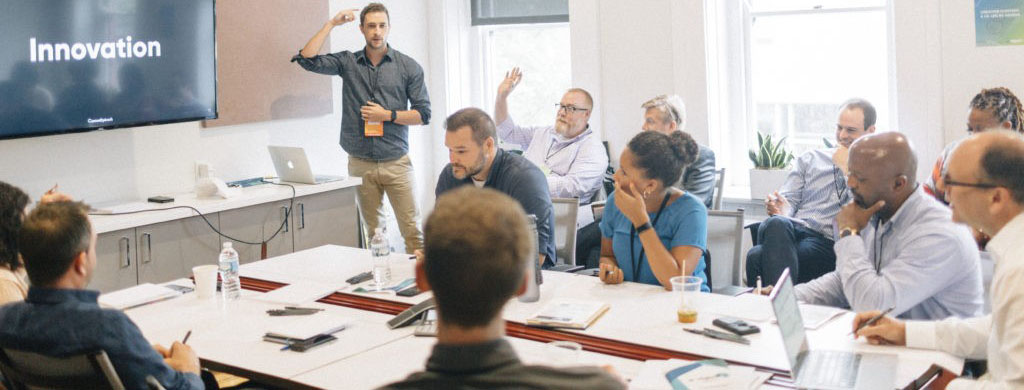Big Companies

BigCos need to align with, learn from, and use startup talent, products, and services in order to catalyze an innovation economy.
#Disruption is certainly a sexy meme these days for BigCos and startups alike—and it has plenty of merit. But for those leading and building entrepreneurial ecosystems, the best strategy for sustainable engagement and connectivity between BigCos and startups is a collaborative one. Both parties face unique business challenges that new perspectives and solutions can potentially solve. And, ultimately, both can make an important contribution to the community’s growth, diversity, and vibrancy.
So then, how can we break down the barriers to collaboration? The faceted solution involves introducing fresh perspectives that set conditions for curiosity, candor, and connectivity to take hold and flourish.
WHY BIGCOS AND STARTUPS NEED EACH OTHER
Endeavor Insights’ recent report recommends that, for local economies to drive growth and productivity, key decision-makers should “support existing high-value, entrepreneurial companies as they continue to grow.” However, the relationship between big companies and startups is often exclusively seen as one of “corporate social responsibility,” where BigCos sponsor activities or approve pilot projects with startups as a way to show support for their local community. This is a limiting view. Although community spirit is essential, corporations should deeply engage in entrepreneurial capability along the continuum of startup life cycles.
BigCos need to align with, learn from, and use startup talent, products, and services in order to catalyze an innovation economy. In a recent Forbes article, serial entrepreneur Hod Fleishman says that to do this well, “There needs to be more transparency about the problems corporates seek to solve, more agility in trialing solutions, better solutions for investment, and the sharing of IP, and the fruits of success.” The larger goal is for all activity between BigCos and startups to be interconnected and mutually fulfilling. For startups, that means learning how to work with large companies and understanding the challenges that come with operating at that scale. For BigCos, it means learning how to be more open to new, creative approaches and business models, and agile processes that encourage experimentation and speed. But what does this relationship actually look like?
IT LOOKS LIKE COLLABORATION
To illustrate the impacts and successes that can emerge from BigCo and startup partnerships, there’s no better example than CVG Airport and its collaboration with local startup Losant. Brian Cobb, Chief Innovation Officer at CVG Airport, understands the role tech innovation plays in the growth of his organization. More importantly, he recognizes how this growth directly impacts the region’s economic vibrancy. And so does CVG. Even their mission positions CVG as “an essential part of the region’s overall growth and success through teamwork, innovation, and continuous improvement.”
But like most large and established industries, the aviation sector is slow to innovate new business models and source, select, and implement tech innovation. CVG not only acknowledges the slow-moving nature of the industry, but, lucky for Southwest Ohio and Northern Kentucky, it sees startup collaboration as a high-impact way to catalyze innovation.
To CVG, startup collaborations are meant to propel business partnership and community—all with the ultimate goal of improving the CVG Airport passenger experience. With the support of CEO Candace McGraw and a small, aggressive team, Brian builds innovation strategies that align with CVG’s Four Pillars of Innovation: connect (digital solutions for airporti nnovation); clean (waste reduction and environmental sustainability); secure (cyber and campus security); and transport. He wouldn’t hesitate to tell you that active engagement with the startup community has been a key driver of their innovation success.
“No other airport in the region is working with startups in a capacity like this. Selfishly, I would say we’re pretty far ahead of the game, even domestically. Outside the U.S., it’s a different story; (those) in Germany and London see the opportunity, but there’s nothing that says we shouldn’t be playing in that space, too. And we all know the startup ecosystem around Cincinnati is on fire, which is incredibly fortunate for us on so many fronts.”
– BRIAN COBB, CHIEF INNOVATION OFFICER AT CVG AIRPORT
On behalf of CVG’s innovation strategy, Brian has been an active participant in Startup Cincy and Cintrifuse activities, where he connects with local startups like Losant. He found a kindred spirit and collaborator in Losant CEO, Charlie Key, who upon graduating from The Brandery and Techstars accelerator programs became a serial entrepreneur. Now a highly regarded mentor in the Startup Cincy ecosystem, Charlie’s focus has been to create IoT solutions on the enterprise-level with their IoT cloud platform. Together, Brian and Charlie worked to identify a problem and co-design a solution for one of CVG’s key innovation pillars: connect.

The problem they chose to solve was for CVG’s indoor train, which had become a common source of confusion for travelers. CVG found that travelers weren’t sure if they should wait for the train or walk to the terminal. Some passengers mistakenly believed the train would take them into the city. Passengers then opted out of using the train.
To address this issue, CVG’s innovation team and Losant implemented an IoT solution that now collects data travel times and provides passengers with the information they need about the indoor terminal train. This looks like large monitors installed outside of each train boarding station that estimate walking time, real-time train location, and wait times. According to Losant’s Case Study, by installing and connecting train tunnel sensors to the Losant Enterprise IoT Platform, “the airport was able to better inform its customers about how to use the train.” With this solution in place, passengers can now use their time more efficiently and effectively while at the airport.
This is just one example of how large, established organizations can leverage startup talent to create solutions and ultimately transform all involved for the better.

HOW TO SET THE CONDITIONS FOR STARTUP AND BIGCO COLLABORATION
The way ecosystem leaders set the stage for these collaborations is paramount to their impact on the region’s economic vibrancy. A recent report from Innovation Leader found that 85% of companies focus their startup engagement around “meeting with interesting startups.” Unfortunately, these meetings often fall short when it comes to candid business discussions that lead to mutually beneficial outcomes.
A big part of Cincinnati’s ecosystem success is the purposeful effort to build high-value collaborations between BigCos and startups, where BigCos candidly share their business challenges; grant serious interest to learning about startup technologies and their approach to business building; and enable scale-up activities for promising startup products and services. To get to the moment where startup technologies are leveraging BigCos to scale and reach mutually beneficial business goals, ecosystem builders have to set the stage well from the start.
In the early part of my tour of duty as CEO at Cintrifuse, a public-private partnership in Southwest Ohio and Northern Kentucky, we experimented with a stage-setting model that specifically focused on building higher value engagement between BigCos and startups. We started by getting a feel for the technology landscape and where BigCos fell on the digital transformation continuum—including their business models. We took an inventory of large companies in the region (those with $100M or above in revenue), along with the growth dynamics of their sector. From that point of view, we could more clearly identify innovation opportunities and how connections could be made by exposing large organizations to horizontal tech themes that could impact their organic growth or internal efficiency. We also became fans of CB Insights. Their sector research showed examples of how specific industries were being “unbundled” by new technologies. This research caught the attention of some large companies (P&G and Kroger) in the region who were actively looking for a new strategies for organic growth.
This is the true work of an ecosystem builder, where every program, activity, and introduction needs to be delivered intentionally and with a maximalist mindset that sets the conditions for collaboration that builds momentum across the entire ecosystem.
When we started our mission to catalyze startup innovation in Cincinnati, I already knew how impactful creating conversation between large companies and startups could be. But with 150 BigCos in the area, there were too many companies to pair with our startups for one-on-one conversations. The mission of Cintrifuse was strategic and broad yet our team (and our budget) was small.
This is where the idea to host informal, digital transformation “meet-ups” was born. The idea is to invite digital thought leaders and investors from outside the region, or leaders from other parts of the local ecosystem— proven entrepreneurs, academics, and government leaders to name a few—to share their expertise on relevant horizontal tech themes emerging across our region’s BigCos. These informal gatherings were an opportunity for large company leaders to listen to expert insights on their business challenges and the role technology innovation played in that category. From there, BigCos could begin to see startups as potential problem- solvers and collaborators. That’s when the foundation for an innovation economy truly gets set.

In planning these early learning meet-ups, we used a pull strategy, where we leveraged our network of high-profile digital experts, welcoming
those from outside the region like industry analysts Michael Krigsman and Ray Wang, to share their insights on top tech priorities to a combined audience of BigCo leaders and entrepreneurs. Large companies could then self-select their interests and then move toward startup innovation—as opposed to a push strategy where companies would have been coerced into the room and prematurely matched with a startup.
For the pull strategy to succeed, we had to experiment with adding value across the ecosystem’s various themes so that both BigCos and Startups would want to engage. We had to bring folks together around a specific theme and get them comfortable talking with each other despite coming from different entities.
For one of our first “meet-ups,” we honed in on “The Future of Work” as the major theme. We invited Ben Casnocha—co-author of The Alliance, venture capitalist with Village Capital, and entrepreneur—along with 50 HR leaders to LPK’s Innovation Center. As a thought leader who has engaged with many nodes of an innovation ecosystem, Ben shared a well-rounded perspective on what new employees look for in relationships with their employers. After his 30-minute talk, the audience got to hear from a panel of startups who had invested and built innovation around the future-of-work trend. Startup founder of Cerkl and meet-up participant, Tarek Kamil, reflected on the experience by describing the high value startups place on honest feedback from corporates.
“We went in with the appropriate expectations to learn and receive feedback from the Corporates. Sales was not the motivator, although we did get sales from the events. We had to ask tough questions like, ‘Would you actually use this product or service? Why or why not?’ We learned so much through every one of those exchanges.”
– TAREK KAMIL, MEET-UP PARTICIPANT

With ecosystem-building in mind, our small-but-mighty team at Cintrifuse took note of the folks who raised their hands and were most willing to learn from the entrepreneurs in the room. We were looking for leaders who had very specific cultural or digital transformation needs. That way, when the event concluded, we had a path forward to corporate engagement initiatives.
Startup leaders who were ready to engage, like Tarek, could then meet with BigCos to continue the conversation and create mutually beneficial relationships. In fact, Tarek’s team ended up closing a deal with a BigCo within 45 days of the event, and ultimately, Cerkl’s solution tripled employee engagement for that BigCo.
Something truly powerful happened within this single 90-minute event. Ben’s perspective was perfect fodder for natural conversation about the problem of attraction, development, and retention of millennial employees. Combine his research with the audience’s curiosity, and we had a room full of HR directors well-equipped to build relationships with startups. Over time, the startups could position their products and services as solutions to the BigCos’ problems.
THREE PRACTICAL WAYS ECOSYSTEM BUILDERS CAN SPARK COLLABORATION BETWEEN BIGCOS AND STARTUPS:
1. DETERMINE SPECIFIC TECH PRIORITIES THAT ARE RELEVANT TO REGIONAL BIGCOS ACROSS SECTORS AND COMPANY SIZE
Identify themes like the future-of-work trends (HR), consumer experience, cyber security, blockchain, robotics, and AI.
2. HOST INFORMAL DIGITAL INNOVATION MEET-UPS THAT ADDRESS SELECT DIGITAL TRANSFORMATION THEMES
These events should be small and provocative, prompting candid interaction between the BigCos with problems, and startups who can solve them. These events need to be interactive, iterative, and rich with dialogue that begins to build trust and the connective tissue required for collaboration.
3. ASSESS AND SELECT KEY BIGCO AND STARTUP PLAYERS TO ENGAGE IN MORE INDIVIDUALIZED CONVERSATIONS
Take a supportive role with the relationships between the large companies and startups. Be available for support when processes are slow and barriers emerge. Track the relationships and communicate their impact over time to your ecosystem.
BREAKTHROUGHS OCCUR WHEN ECOSYSTEM BUILDERS SET THE RIGHT CONDITIONS
Surveying the landscape to identify horizontal themes. Pulling BigCos and startups into conversation by making the value potential real and tangible. Creating environments that spark high-value, low-stakes organic collisions among BigCo and startup stakeholders. Then, once trust is built, pairing up stakeholders with the strongest impact potential.
This is how an innovation economy evolves into a robust engine for economic vibrancy. Every node in the ecosystem (whether it’s BigCos, startups, universities, government stakeholders, or venture capitalists) has strengths as well as challenges that they face. But they need activation energy and the opportunity to collide. They need the support of ecosystem leaders who operate with a maximalist mindset.
That’s what we do as ecosystem builders. It’s our North Star to craft conditions for collisions among the right players. Because once an idea ignites—so long as entities in the region embrace a collaborative spirit—the region’s vibrancy grows.
